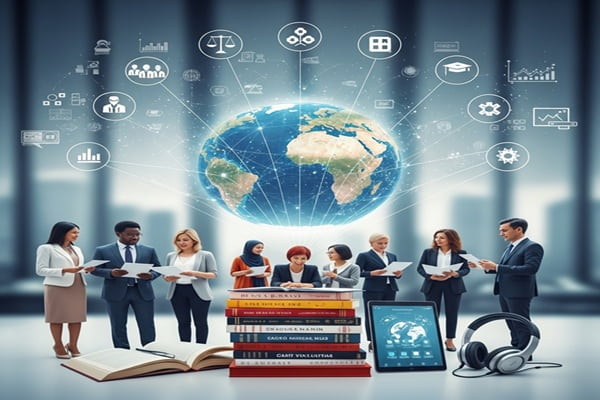
Newsletter Subscribe
Enter your email address below and subscribe to our newsletter

Enter your email address below and subscribe to our newsletter

Ever stumbled across the term “преводсч” and wondered what it means? In simple terms, it refers to modern translation tools—whether apps, services, or software—that help you convert one language into another. In today’s global world, where conversations span continents, kultura, and media, these tools aren’t just helpful—they’re game-changers. Let’s explore how translation services work, the top platforms available, current limitations, and why this tech matters now more than ever.
The word преводсч essentially means “translator” or “translation tool” in Bulgarian.
It’s an umbrella term for services that help convert text, audio, or content between languages.
Whether you’re chatting online, reading, or working internationally, преводсч tools are the bridge that make communication seamless.
In just a few years, what once needed fluent interpreters or language experts is now available in seconds:
Global business becomes possible across languages.
Travel and tourism are easier with instant translation.
Education and research benefit from language accessibility.
Media and entertainment break borders, delivering manga, news, or video in tons of languages.
Whether you’re a global entrepreneur, a curious learner, or a digital creator, these tools give you access to beyond your native language.
Supports over 100 languages—text, speech, images, documents.
Offers real-time conversation mode and handwriting input.
Works online or offline, plus it’s free and mobile-friendly.
Great for everyday communication, quick searches, or content access.
Combines translation with dictionary-style definitions, usage examples, and idioms.
Ideal for learners, writers, and professionals who need deeper context.
Covers multiple European languages with precision and grammatical clarity.
Offers 102 language pairs, pronunciation guides, and transcription.
Excellent for Slavic languages, nuanced translations, and spoken use.
Includes examples from real-life usage to reduce ambiguity.
Built into Microsoft Office, Teams, and the Azure ecosystem.
Handles text, voice calls, and real-time conversation.
Also offers robust offline capabilities—handy when you’re offline or traveling.
Updates through Azure AI, ensuring steady improvements in translation accuracy and speed.
Translation started as literal word-for-word output—now it uses Neural Machine Translation (NMT). This means:
AI learns language patterns from millions of examples.
Resulting translations are more fluid and context-aware.
Real-time translation and developer APIs embed translation into apps and workflows.
In short, these tools evolved from static dictionaries to smart assistants.
Translating expressions like “break a leg” literally doesn’t work. Advanced tools are learning to interpret intent and tone—but they’re not perfect yet.
Fields like law, medicine, or tech use niche vocabulary. Misinterpreting these can cause confusion or mistakes.
Poetry, humor, and abstraction require human sensitivity that AI is still catching up to.
Many services collect user data to improve algorithms. When you translate sensitive text, be sure to check the platform’s privacy policy and local regulations.
Travelers can chat easily and read menus abroad.
Language learners can double-check translations instantly.
Social media users can engage in global conversations.
Global customer support can happen in multiple native languages.
Websites and apps can be multilingual via API integrations.
Teams spread across countries can collaborate more efficiently.
| Platform | Languages Supported | Offline Access | Best For |
|---|---|---|---|
| Google Translate | Over 100 | Yes (download) | General everyday use |
| PONS Translator | Multiple European | Partial | Professional/educational use |
| Yandex Translate | 102 | Yes | Slavic languages, context |
| Microsoft Translator | Over 100 | Yes | Business, Teams, offline use |
Smarter NMT tools that adapt to tone, style, and domain.
Multimodal translation: combining text, voice, video, and AR for seamless cross-language experiences.
Industry-specific tools, like medical or legal translators with domain-specific vocabulary.
Interactive multilingual chatbots and assistants able to converse fluently across cultures.
In short, translation tools are moving toward richer, smarter, and more embedded experiences.
Also Read : Innovation News DualMedia: The Future of Digital Tech Journalism
Translation tools—what we call преводсч—are no longer optional. Whether you’re a traveler, a student, a small business, or a global creator, these services offer access, communication, and clarity across language barriers. While each platform has its strengths and limitations, tools like Google Translate, PONS, Yandex, and Microsoft Translator are powerful, reliable, and accessible to almost everyone.
Adopting these platforms means embracing a more connected, multilingual future. With ongoing advances in AI and language tech, translations will only become smarter, smoother, and more natural—making global communication feel as easy as chatting with a friend.
What is преводсч?
Преводсч translates roughly to “translator” or “translation tool” in Bulgarian, and refers to modern digital services that convert one language to another.
How do tools like Google Translate work?
They use machine learning, especially neural machine translation, combined with huge language databases to predict natural-sounding translations.
What languages do these translators support?
Most cover 100+ languages, including widely spoken ones and many regional dialects.
What about concerns around data and privacy?
Translation services often store and analyze text inputs to improve models. Review each service’s privacy policy—especially when translating sensitive content.
How can businesses use translation tools?
By embedding translation APIs into their websites, apps, or support systems, companies can offer real-time multilingual content without hiring translators.